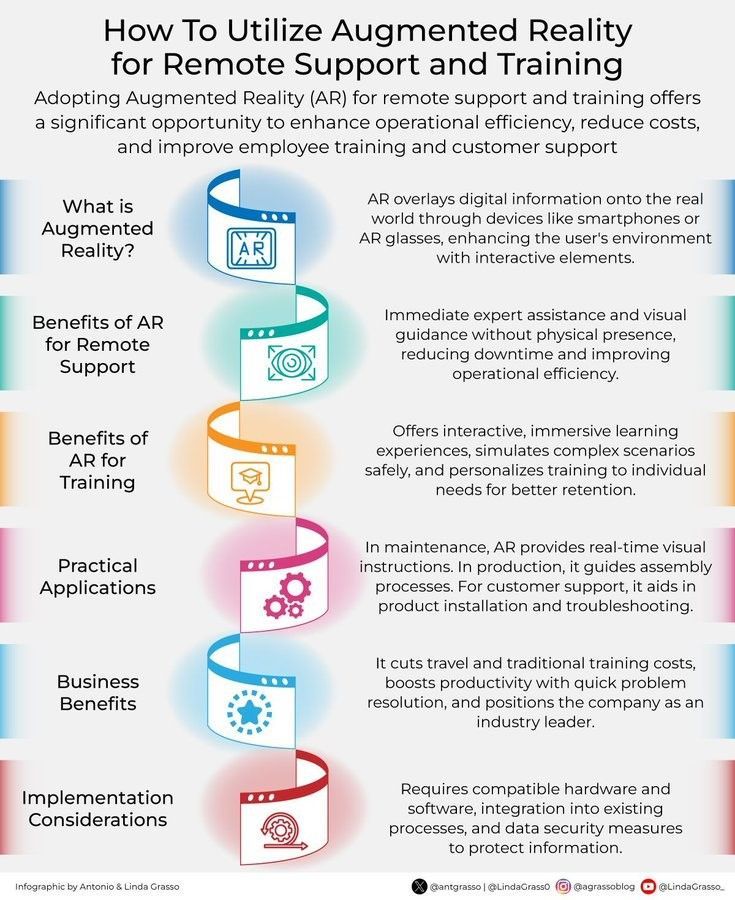Augmented Reality (AR) is revolutionizing the way we approach remote support and training. With the rapid advancements in AR technology, industries are finding innovative ways to enhance their training programs and provide efficient remote support. This article explores the various applications of AR in these fields and highlights some of the latest trends and innovations.
The Rise of AR in Remote Support
Remote support has always been a challenge, especially in industries that require hands-on assistance. However, AR is changing the game by providing real-time, interactive support. Technicians can now use AR glasses or mobile devices to receive visual instructions overlaid on their physical environment. This not only improves accuracy but also reduces the time required to resolve issues.
Key Benefits of AR in Remote Support
- Real-Time Assistance: AR allows experts to guide technicians remotely by overlaying digital information on the physical world. This real-time assistance can significantly reduce downtime and improve efficiency.
- Enhanced Visualization: With AR, technicians can visualize complex components and understand intricate details without needing to refer to manuals or diagrams.
- Hands-Free Operation: AR devices like smart glasses enable hands-free operation, allowing technicians to focus on the task at hand while receiving guidance.
- Improved Training: AR can be used to create immersive training experiences, enabling technicians to practice and learn in a virtual environment before applying their skills in the real world.
AR in Training Programs
Training programs across various industries are leveraging AR to provide more engaging and effective learning experiences. From medical training to industrial skills development, AR is proving to be a valuable tool.
Applications of AR in Training
- Medical Training: AR is being used to simulate surgeries and medical procedures, allowing students to practice in a risk-free environment. This hands-on experience is invaluable in building confidence and competence.
- Industrial Training: AR can simulate complex machinery and processes, enabling trainees to understand and operate equipment without the risk of damage or injury.
- Soft Skills Training: AR is also being used to enhance soft skills training, such as communication and customer service, by creating realistic scenarios for practice.
- Educational Institutions: Institutions like IIT Madras are partnering with tech companies to offer AR/VR programming courses, addressing the growing demand for skilled AR/VR professionals. Read more
Innovations and Trends in AR
The AR industry is witnessing rapid innovations, with companies continuously pushing the boundaries of what is possible. Here are some of the latest trends and innovations in AR:
- AI-Generated AR Experiences: Companies like Snap are integrating AI with AR to create real-time, on-device image diffusion models for AR experiences. This allows for interactive and dynamic AR experiences driven by text prompts. Read more
- Assistive Technology: Startups like Augmental are developing smart devices with head tracking and silent speech capabilities for hands-free device control, offering voiceless communication and control for people with disabilities. Read more
- Enterprise Applications: Companies like Apple are focusing on integrating AR with enterprise device management, providing features like security and identity management for a wide range of enterprise use cases. Read more
- Immersive Art Installations: The Texas arts and tech fest showcased how VR and AR are being used to create immersive art installations and AI-generated VR experiences, highlighting the growing interest in VR/AR applications beyond gaming. Read more
Challenges and Ethical Considerations
While AR offers numerous benefits, it also presents certain challenges and ethical considerations:
- Data Privacy: AR collects and processes large amounts of data, raising concerns about privacy and security.
- Accessibility: Making AR accessible to people with disabilities is essential for inclusive use.
- Cost: High costs of AR devices and development can limit adoption, especially for small businesses and schools.
- Health Concerns: Prolonged AR use may cause eye strain and motion sickness, requiring solutions for safe usage.
Conclusion
Augmented Reality is transforming the way we approach remote support and training. With continuous innovations and increasing adoption, AR is set to become an integral part of various industries. By addressing the challenges and ethical considerations, we can harness the full potential of AR to create more efficient, engaging, and inclusive experiences.
Check out more AI tools.
Elevate Guest Experience with RoomGenie
Textify Analytics – Affordable Insights at the Speed of AI
